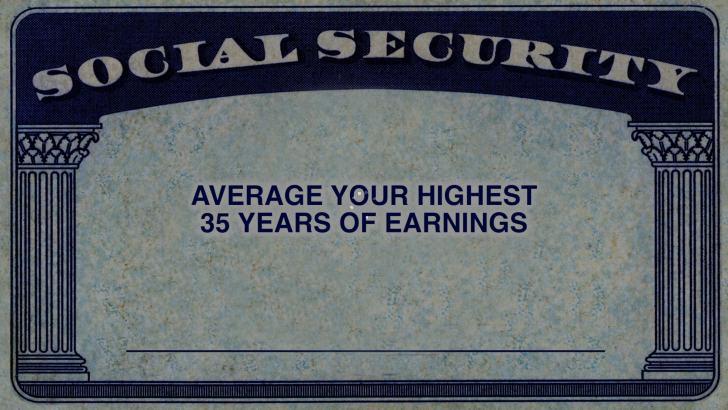April 11, 2016
April is turning out to be cruelest month in more ways than one. Not only do we have to deal with all things tax day, but some boomers face another costly deadline on April 29: they could lose many thousands of dollars in Social Security benefits.

April 11, 2016
April is turning out to be cruelest month in more ways than one. Not only do we have to deal with all things tax day, but some boomers face another costly deadline on April 29: they could lose many thousands of dollars in Social Security benefits.

Yep, that’s the last day folks who qualify can take full advantage of the file-and-suspend Social Security claiming strategy. After April 29, 2016, file-and-suspend becomes a thing of the past.
Why so? The Bipartisan Budget Act of 2015, signed into law in November, essentially strangled shut what lawmakers described as unintended loopholes — the file-and-suspend and the restricted application strategies.
It’s important to note that April 29 is the deadline for the file-and-suspend strategy, but it is not the deadline for filing a restricted application.
“The restricted application strategy doesn’t really have a deadline,” said Jeffrey Levine, a retirement expert with Ed Slott & Co. and author of The Definitive Guide to Required Minimum Distributions for Baby Boomers. “You just had to be a certain age or older by Jan. 1, 2016 to be able to use it when you’re eligible.”
Under the old law, those born before Jan. 2, 1954 could not file a restricted application before full retirement age (FRA), but they could file a restricted application at or after FRA, according to Andy Landis, author of Social Security: The Inside Story.
Under the new law, you can no longer file a restricted application at all — before, at, or after your full retirement age — if your birth date is after Jan. 1, 1954.
And know this: There is a clear distinction between “file and suspend” and “restricted application,” said Michael Kitces, author of the Nerd’s Eye View blog. “By far, the most common question I get is someone thinks they need to do something by April 29, because they think they’re doing a file and suspend (and call it file and suspend), when the reality is that they plan to do a restricted application,” Kitces said in an email.
He gave this example:
Question: I’m a divorced spouse who wanted to get my ex-spouse’s benefit. Do I need to file and suspend by April 29 to get this?”
Answer: No, because you’re not doing a file-and-suspend. You’re doing what’s called a restricted application. And the April 29 date is not relevant for restricted application. Just go in and do the restricted application whenever you actually reach full retirement age, presuming you’re born in 1953 or earlier.
By way of background:
- The role of file-and-suspend was to allow someone else to get spousal benefits while the primary worker delayed his/her own benefit
- And the purpose of restricted application was for someone to get their own spousal benefit while delaying their own individual retirement benefit
- This is according to Kitces’ blog on the subject. Read Navigating The Effective Date Deadlines For The New File-And-Suspend And Restricted Application Rules.
- The good news? There’s still time for Americans, again those who qualify, to take advantage of file and suspend and/or restricted application. Here’s what you need to know.
Get a bead on your benefits right now
But before we do, it’s worth noting that now would be a good time to identify all the Social Security benefits you and your family members may be entitled to, now or in the future. So says Elaine Floyd, director of life planning and retirement at Horsesmouth.
“In addition to your own retirement benefit, you may be eligible for a spousal benefit based on your spouse’s work record,” she said. “Or your spouse may be eligible for a spousal benefit based on your work record. And if you have minor children, they could be eligible for benefits if a parent is collecting benefits or is deceased. And, if you are divorced or widowed, you may be eligible for a benefit based on your former spouse’s work record.”
Learn the rules and find out what benefits you are eligible for and when. Go to Retirement Planner: Plan For Your Retirement.
Plan when to file
Next, make a plan for when to file. “For example, if you are married and you are the higher earning spouse, you should probably plan to file for your retirement benefit at age 70 in order to get maximum delayed credits,” Floyd said. “This will also maximize the survivor benefit to your spouse if you should die first. If your spouse will be claiming a spousal benefit based on your record, you will need to file for your benefit first. If you will not be age 70 when your spouse is ready to take the spousal benefit, you can file and suspend. This will trigger the spousal benefit for your spouse while your benefit continues to build delayed credits.”
File and suspend
If you were born on April 30, 1950 or earlier, we’ve got good news: the file-and-suspend strategy is still available to you at full retirement age or FRA (66 for those born between 1943 and 1954). And this holds true for married couples, unmarried divorced spouses, parents with dependent/disabled children, and singles. But you must file and suspend before April 30, 2016. By doing so, you’ll be able to take advantage of the old rules.
“If you’ll be 66 by April, definitely explore whether you should file and suspend before April 30,” said Landis. “You’ll be under the much better ‘old’ rules for voluntary suspension with three advantages: you can suspend and grow your payments, open the door to family payments for your spouse or child, and later choose to collect your back payments if you need to.”
Under the new rules, you can still file and suspend your Social Security benefit; it will continue to increase (up to age 70) until you unsuspend it. But family payments for your spouse or child won’t be available nor can you choose to collect your back payments, according to Landis.
Landis also noted that if you’re a “dualie,” that is, someone eligible for Social Security in two or more ways (from your own work and that of a spouse or ex-spouse), be sure to run your numbers through an online calculator such as that found at Financial Engines. Landis said that calculator has been updated to the new rules and can suggest an optimal filing strategy.
Levine offered this general advice for file-and-suspenders:
- Review if you’re old enough to be able to use the strategy – you must file-and-suspend by April 29, 2016 to use this approach, but you must also be 66 or older by that time.
- If you’re old enough to be able to use the strategy, check to see if it makes sense. Will someone else be able to claim a benefit based on your earnings history? Do you want to enable yourself to have the right to claim lump-sum benefits retroactively should a health or other issue make it useful to do so in the future?
- If so, get your you-know-what in gear and get on over to the Social Security Administration (SSA) office ASAP
- Verify your request was processed correctly. If you file-and-suspend, you should not be receiving benefits based on your earnings history. If you start to receive checks that don’t seem “right,” don’t ignore them and think it’s “found money.” It could mean that your request was processed incorrectly. If so, those checks now could come at the expense of larger checks later that last for the rest of your life and/or a spouse’s life. If you encounter an error, notify the SSA right away.
Of note, if you were born May 1, 1950 or later and currently married you can still file and suspend (you can start, stop and restart your benefit), but you’re no longer eligible for family payments and unsuspend retroactively. Unmarried divorce spouses who qualify can file and suspend, but Landis advises this group to talk to experts and/or the SSA first.
“If you won’t be 66 by April 29, you will not be able to file and suspend and you will have to decide which is more valuable: the spousal benefits or the delayed credits,” said Floyd, who noted that the advisers trained in Horsesmouth’s Savvy Social Security Planning for Boomers program have a spousal planning calculator that can help with this analysis.
File-and-suspend resources:

Social Security benefits
- SSA website
- SSA Program Operations Manual (POMS): POMS GN 02409.100 ff; POMS GN 02409.130 B; Emergency Message 16007
- Bipartisan Budget Act of 2015, Sec. 831(b)
Restricted application
The April 29 deadline applies only to the voluntary suspension rules But restricted application rules — filing only for spouse or ex-spouse payments and delaying your own for more money later — are determined purely by your birth date, Landis noted.
If you were born on Jan. 1, 1954 or before, then you qualify to use restricted application when you’re 66. But if you were born on Jan. 2, 1954 or later, you can’t take spousal payments and delay your own. “You’ll file for both at the same time,” said Landis.
Floyd said individuals who are, or ever were, married and who were 62 or older at the end of 2015 have a unique opportunity to take advantage the restricted application loophole that is closing. “You can file a restricted application for your spousal benefit when you turn 66 and receive 50% of your spouse’s primary insurance amount (PIA) while your own retirement benefit builds delayed credits to age 70,” she said. “This is a tremendous opportunity to receive tens of thousands of dollars in spousal benefits while increasing your own permanent retirement benefit.”
To do this, Floyd said you must not file for your own retirement benefit. You must wait until you turn 66. “At that time, you file a restricted application for your spousal benefit and begin receiving 50% of your spouse’s PIA (your spouse must have previously filed for his or her benefit). When you turn 70 you switch to your own maximum retirement benefit if it is higher.”
Levine had this advice about the restricted application strategy:
- Review if your old enough to be grandfathered in to the “old” rules — you had to be 62 or older by Jan. 1, 2016.
- If so, see if it makes sense to use. Do you have a spouse that has/will file for their own benefits after you reach FRA (66) but before you want to claim your own benefit? Note that if you had planned to use the file-and-suspend strategy but were phased out due to your age, you may still be able to use the restricted application strategy.
- If so, remember that you can only file a restricted application once you reach your FRA (66). Once you’ve reached that age file your restricted application (assuming your spouse has filed).
- Verify your request was processed correctly. Remember, if you’re filing a restricted application for spousal benefits, your check should be one-half of what your spouse received (or would have received) at FRA. So, for instance, if you get a check that’s relatively high — say $2,400 for the first month — you know something’s wrong. Your spousal benefit could not possibly be that high. Notify the SSA immediately of the error. Chances are your request was filed incorrectly and they’ve paid you your own benefit instead of your spousal benefit.
Restricted application resources
- SSA website
- Social Security Handbook
- SSA Program Operations Manual (POMS): POMS GN 204.004 B; POMS GN 204.020 D
- Bipartisan Budget Act of 2015, Sec. 831(b)
Other scenarios
Unmarried divorced spouse: A divorcee can choose to file and suspend, and can still do so before April 30, 2016. The restricted application tactic is still available to you at FRA provided your former spouse is also older than age 62. If you were under age under age 62 in 2015, you’re not eligible to file a restricted application.
Surviving spouse: Good news — sort of. The new rules are not applicable. You can still independently choose the timing of when to start survivor and individual retirement benefits. “Heaven forbid, but if you are a widow or widower, Congress hasn’t changed the rules for you,” said Landis. “A restricted application strategy is still available. You could take the widow’s payment as early as age 60, then switch to your own at 70. Or for many people the opposite path is best: take your own Social Security at 62, then switch to your widow’s payment at 66. There are lots of rules, so be sure to check with Social Security.”
After April 29
So what if you read all this after April 29, 2016? According to Landis, voluntary suspension is still available even under the new rules passed by Congress. “You can still apply the strategy to maximize your Social Security,” he said.
Landis gave the following examples:
- You’re under 70 and already took Social Security. Now you’ve come into some money (a new job, an inheritance, whatever) and don’t need the Social Security. You can suspend your Social Security for any months from 66 to 70, and your payments will be bigger when they restart. The increased payments will pay you back for the rest of your life, and might even continue for your spouse’s life too.
- You’re 62 and retired, and have a teen child or stepchild. Your age-66 Social Security will be $1,000. You file for Social Security at 62 for a reduced payment of $750 (75% of $1,000). Your child gets $500 Social Security on your work record (50% of your $1,000). When you’re 66, your child has graduated from high school and is no longer eligible. However, you’ve “front-loaded” your Social Security with $60,000 ($750 + $500 times 48 months). You suspend your Social Security from 66-70, and your payment restarts at 70. Your payment has grown to $990 (132% of your original $750). Basically you’ve gotten a $60,000 head start, but also wiped out your reduction for filing early.
“The bottom line is that there are still lots of ways to use voluntary suspension or restricted application, even under the new rules,” said Landis. “Some doors are closing, but others are still open.”
Others agree: “Social Security rules and strategies are very complex, especially the interaction of retirement and spousal/survivor benefits. Most people fail to maximize their benefits, simply because they don’t understand how to do it,” said Floyd. “Loopholes are closing, but some people can still take advantage of them.”
One last bit of advice. Social Security rules are quite complex. (If you want proof, read the Program Operations Manual System (POMS).) So, before making any decisions, consult your financial adviser and the Social Security Administration. “Find an adviser with expertise in Social Security claiming rules and strategies who can guide you through the maze,” said Floyd. “Doing the right thing at the right time can net you many thousands of dollars more in lifetime benefits.”
Courtesy: MarketWatch















































































































